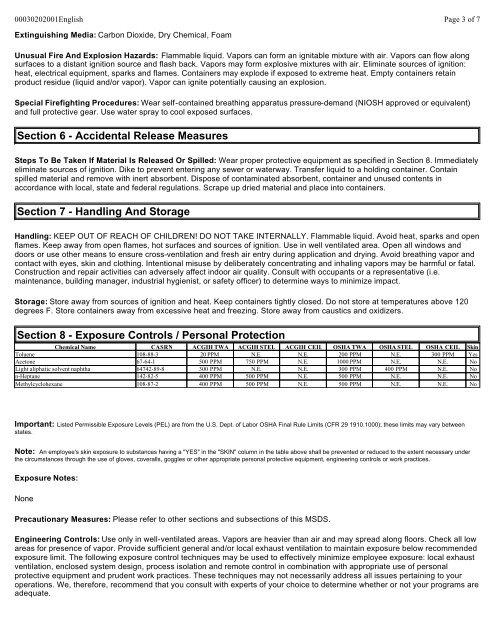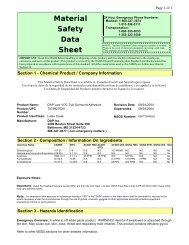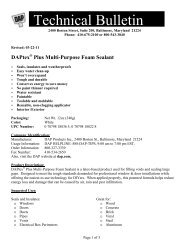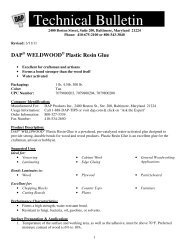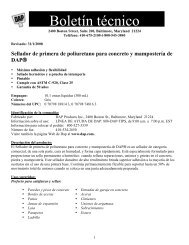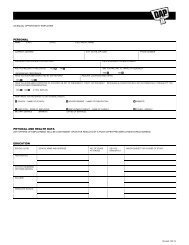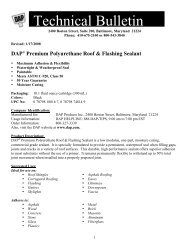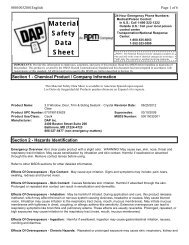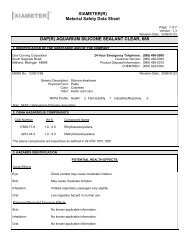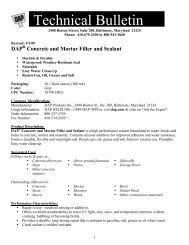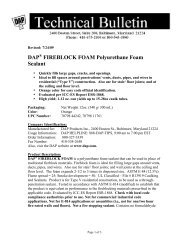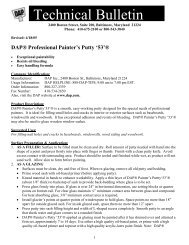00030202 - Dap
00030202 - Dap
00030202 - Dap
You also want an ePaper? Increase the reach of your titles
YUMPU automatically turns print PDFs into web optimized ePapers that Google loves.
<strong>00030202</strong>001English<br />
Page 3 of 7<br />
Extinguishing Media: Carbon Dioxide, Dry Chemical, Foam<br />
Unusual Fire And Explosion Hazards: Flammable liquid. Vapors can form an ignitable mixture with air. Vapors can flow along<br />
surfaces to a distant ignition source and flash back. Vapors may form explosive mixtures with air. Eliminate sources of ignition:<br />
heat, electrical equipment, sparks and flames. Containers may explode if exposed to extreme heat. Empty containers retain<br />
product residue (liquid and/or vapor). Vapor can ignite potentially causing an explosion.<br />
Special Firefighting Procedures: Wear self-contained breathing apparatus pressure-demand (NIOSH approved or equivalent)<br />
and full protective gear. Use water spray to cool exposed surfaces.<br />
Section 6 - Accidental Release Measures<br />
Steps To Be Taken If Material Is Released Or Spilled: Wear proper protective equipment as specified in Section 8. Immediately<br />
eliminate sources of ignition. Dike to prevent entering any sewer or waterway. Transfer liquid to a holding container. Contain<br />
spilled material and remove with inert absorbent. Dispose of contaminated absorbent, container and unused contents in<br />
accordance with local, state and federal regulations. Scrape up dried material and place into containers.<br />
Section 7 - Handling And Storage<br />
Handling: KEEP OUT OF REACH OF CHILDREN! DO NOT TAKE INTERNALLY. Flammable liquid. Avoid heat, sparks and open<br />
flames. Keep away from open flames, hot surfaces and sources of ignition. Use in well ventilated area. Open all windows and<br />
doors or use other means to ensure cross-ventilation and fresh air entry during application and drying. Avoid breathing vapor and<br />
contact with eyes, skin and clothing. Intentional misuse by deliberately concentrating and inhaling vapors may be harmful or fatal.<br />
Construction and repair activities can adversely affect indoor air quality. Consult with occupants or a representative (i.e.<br />
maintenance, building manager, industrial hygienist, or safety officer) to determine ways to minimize impact.<br />
Storage: Store away from sources of ignition and heat. Keep containers tightly closed. Do not store at temperatures above 120<br />
degrees F. Store containers away from excessive heat and freezing. Store away from caustics and oxidizers.<br />
Section 8 - Exposure Controls / Personal Protection<br />
Chemical Name CASRN ACGIH TWA ACGIH STEL ACGIH CEIL OSHA TWA OSHA STEL OSHA CEIL Skin<br />
Toluene 108-88-3 20 PPM N.E. N.E. 200 PPM N.E. 300 PPM Yes<br />
Acetone 67-64-1 500 PPM 750 PPM N.E. 1000 PPM N.E. N.E. No<br />
Light aliphatic solvent naphtha 64742-89-8 300 PPM N.E. N.E. 300 PPM 400 PPM N.E. No<br />
n-Heptane 142-82-5 400 PPM 500 PPM N.E. 500 PPM N.E. N.E. No<br />
Methylcyclohexane 108-87-2 400 PPM 500 PPM N.E. 500 PPM N.E. N.E. No<br />
Important: Listed Permissible Exposure Levels (PEL) are from the U.S. Dept. of Labor OSHA Final Rule Limits (CFR 29 1910.1000); these limits may vary between<br />
states.<br />
Note: An employee's skin exposure to substances having a "YES" in the "SKIN" column in the table above shall be prevented or reduced to the extent necessary under<br />
the circumstances through the use of gloves, coveralls, goggles or other appropriate personal protective equipment, engineering controls or work practices.<br />
Exposure Notes:<br />
None<br />
Precautionary Measures: Please refer to other sections and subsections of this MSDS.<br />
Engineering Controls: Use only in well-ventilated areas. Vapors are heavier than air and may spread along floors. Check all low<br />
areas for presence of vapor. Provide sufficient general and/or local exhaust ventilation to maintain exposure below recommended<br />
exposure limit. The following exposure control techniques may be used to effectively minimize employee exposure: local exhaust<br />
ventilation, enclosed system design, process isolation and remote control in combination with appropriate use of personal<br />
protective equipment and prudent work practices. These techniques may not necessarily address all issues pertaining to your<br />
operations. We, therefore, recommend that you consult with experts of your choice to determine whether or not your programs are<br />
adequate.


